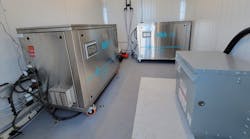Q: My customer has a drilled well about 103 feet deep and it provides water at a rate of about 12 gpm.
The analysis is:
- Hardness: 5 gpg
- pH: 6.0
- Iron: Fe++, 1.0 mg/L
- Manganese: Mg++, 0.20 mg/L
There are no apparent iron bacteria nor sulfur bacteria as the water closet shows no sign of slime.
Additionally, prior to any treatment the water tasted of what was presumed to be iron and the lines (translucent cross-linked polyethylene tubing) were getting discolored with a dark grey or light black within a period of about three weeks.
I decided to install a pellet chlorinator at the well and installed a 40-inch deep backwashing activated carbon filter with a copper-zinc mixture in the house. The result was that the water immediately lost its metallic taste and the lines started to lose the dark color, but over the following nine months they have not completely returned to the original translucent color.
The water still has color that appears a very light red or brown and the water in the toilet shows the discoloration more prominently than a glass of water, for instance. I installed a post-filter with activated carbon with no significant change. The metallic taste has not returned except when the chlorine is a little low. I try to keep the total chlorine level at about one ppm and the free chlorine at two ppm.
What is my next step to get my water cleared up? Do I need a post filter or ion exchange unit? If so, what do you suggest? Should I test the treated water?
— Nova Scotia, Canada
A: You apparently have little hardness in the groundwater because a low pH, such as yours, would dissolve it readily and the total hardness would be much higher. I would not consider ion exchange unless the hardness was higher.
There are many methods for the removal of dissolved iron (ferrous, Fe++) and manganese (manganous, Mn++) from groundwater. Normally, especially with your low pH, the Mn and Fe are dissolved.
Normally, chlorination plus filtration is accomplished by pumping a chlorine solution just ahead of a granular filter medium. Contact time is required after the chlorine feed. A typical residential pressure tank is usually not adequate for this so an additional holding tank is added.
Chlorine pellet feeders plus filtration for Mn and Fe
I am speculating that you are not fully oxidizing the Fe++ and the Mn++. Let”s review your treatment method. You are attempting to oxidize (convert these two minerals from their dissolved state into filterable particles: Ferric, Fe+++ iron and manganic, Mn+++ manganese) by the use of a chlorine pellet feeder. The feeder is good in theory but may not be consistent in practice. Most pellet feeders are not always proportional to the usage (flow rate) in the building. They also have dosage settings that must be properly set or will affect performance.
They also must drop pellets, via a pipe, so that the pellets are discharged below the well pump. Also, during periods of heavy usage, they will drop a high quantity of pellets, which will not immediately dissolve (not be useful). Hence, during heavy usage periods there may not be enough dissolved chlorine pellets to oxidize the iron and manganese. Later, after the pellets dissolve, there might follow a period of low water usage at which time the chlorine dose could be too high. Mn is more difficult to oxidize than Fe. This would explain the grey/black staining in the tubing.
Your filters are all good at removing chlorine, but may not be fine enough to remove small particulates.
Regarding your comments about total and free chlorine, total chlorine is the sum of free chlorine and combined chlorine; therefore, free chlorine cannot be greater than total chlorine.
Treated water tests taken before and after the filtration would definitely help verify the degree of oxidation. Be sure to request both dissolved and precipitated iron and manganese.
See the other types of iron and manganese removal described in the next answer.
Q: I”m hoping you could point me in the right direction for selecting a filtration system for iron and manganese removal from my well water. After my online research I”m a little overwhelmed by the many filtration systems for these. And, based on the reviews I can”t tell what”s valid. Any recommendation as to what type of system I may need based on the results below would be appreciated.
My water analysis is:
- Chloride: 2.6 mg/L
- Nitrate: 0.61 mg/L
- Calcium: 0.45 mg/L
- Copper: < 0.010 mg/L
- Iron: 2.0 mg/L
- Hardness: 2.6 mg/L
- Magnesium: 0.35 mg/L
- Manganese: 0.012 mg/L
- Lead: < 0.0020 mg/L
- Zinc: < 0.010 mg/L
- Alkalinity: 67 mg/L
- pH: 7.3
— South Carolina
A: Your question is very similar to the previous question with the exceptions that you inquired about other types of treatment for Mn and Fe removal and you have lead (Pb) in your water. First, if you haven”t done so already, please read the answer to the previous reader”s question.
Since you inquired about the several types of Mn and Fe removal, I have provided the following other common techniques.
Adsorptive/oxidative filters for Mn and Fe
This type of treatment is a filter medium that both oxidizes and filters the dissolved Fe++ and the Mn++. A typical example of this is manganese greensand that oxidizes and filters both iron and manganese. The addition of prechlorination, as in the answer to the first reader”s question, can be beneficial pretreatment because it acts as a pre-oxidizer and because it can destroy iron and manganese bacteria. But the primary oxidant in the adsorptive/oxidative filters both oxidize, due to the manganese dioxide coating on the filter medium, and filter due to their proper granule size. These filters regenerate with potassium permanganate, KMnO4.
Regular backwashing/regenerating is essential for effective filter performance and requires flow rates that are often higher than the normal building use. Check your well pump rate. About 10 gpm per square foot of filter bed is recommended. If the well system cannot support the needed flow rate for adequate backwashing, poor filter performance (it can harden) and failure are likely.
Standards for iron and manganese are based on levels that cause taste and staining problems and under Environmental Protection Agency (EPA) “Secondary (not a health hazard) Drinking Water Standards.” They call these “recommended maximum contaminant level” (RMCL). For most water supplies 0.3 ppm of iron and/or 0.05 ppm of manganese are objectionable due to staining and taste.
Chlorination (oxidation) plus filtration for Mn and Fe
Similar to the first reader”s question is the feeding of liquid chlorination, by a feed pump, just ahead of the pressure tank but it is more proportional to the flow rate than pellet feeders when water is being used. There must be, in both examples, about 20 minutes of contact time following the chlorine injection before filtration. Add a retention tank for this. The optimum pH of about 8.0 and 8.5 for oxidation of iron and manganese by chlorination is required. Soda ash injected with the chlorine can increase the pH, but it will require a lot to raise pH to 8.0-plus, this optimum level. Consider using sodium hydroxide (NaOH) to raise the pH instead of soda ash.
Other oxidizers, besides chlorine, have been used, such as ozone, air, compressed air, etc., but all have difficulty with the low pH. Your pH and the pH in the first reader”s question are too low to make these methods effective without pH adjustment. Otherwise, the oxidation of these dissolved minerals would be poor at best. Manganese is more difficult to oxidize than iron. A finer granular filter medium than used in the first reader”s question would perform better, assuming thorough oxidation first. A typical example of a finer filter is a multi-layered filter where the top layers are coarse and the bottom layer is very fine. The multi-layered filters have no oxidative properties and cannot remove excess chlorine.
See http://water.epa.gov/drink/contaminants/index.cfm for more information on this.
Treatment methods for lead reduction
Soluble lead levels may be reduced by ion exchange, reverse osmosis, adsorption or distillation. Particulate lead can be removed by fine filtration and adsorption. Water softeners can remove ionic forms of lead but I would not recommend them because the hardness is so low and the process has its limitations.
Removal of lead by reverse osmosis is effective because the membrane removes not only the soluble lead impurities by 90 to 95 percent, but also acts as a barrier to particulate lead. Properly designed and operated distillation units are capable of reducing both suspended and dissolved lead levels.
Solid block carbon cartridge filters using a mixture of activated carbon and a lead adsorbent can remove insoluble lead by particulate filtration and adsorption, and soluble lead by adsorption. These are typically below-the-sink cartridges.
Personally, I use one of these activated carbon block cartridges in the line leading to my refrigerator ice maker and its chilled water dispenser, as well as my other frequently used drinking water faucets. This requires only one cartridge for all the above. It removes all forms of lead as well as cysts, and anything else that is above 5-microns.
Lead, general comments
Your level of lead (0.0020 mg/L) is above the level called “maximum contaminant level” (MCL), which is zero by the EPA, but is below the “action level” of 0.015 mg/L (the level at which a municipality must begin to undertake a plan to reduce the contaminant). So, your lead is not necessarily hazardous to adults but if it is still a concern you can review the treatment methods above.
Studies indicate that nearly all the lead in users” tap water does not come from the primary water source or from a municipal treatment plant, but is a result of corrosion of lead containing materials that contact water after leaving the treatment plant. Lead can enter the drinking water by leaching from lead service connections, from lead solder used in copper piping and from brass fixtures.
David M. Bauman, CWS-VI, CI, CCO, is technical editor of Water Technology® and a water treatment consultant in Manitowoc, Wis. He received his B.A. from the University of Illinois in Industrial Design. He can be reached by email at: [email protected].

